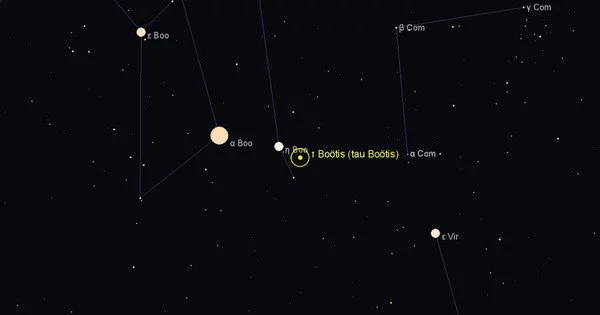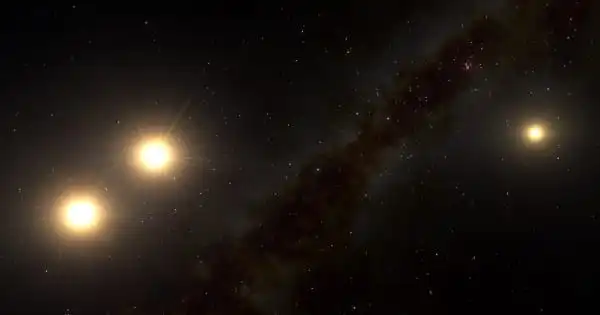Tau Boötis, Latinised from Boötis, is an F-type main-sequence star in the constellation Boötes, located approximately 51 light-years away. Tau Bootis is home to a “hot Jupiter” planet as well as a much further away binary companion. It is a binary star system with a red dwarf as the secondary star. In the constellation Boötes, as a nearby binary star system. Tau Bootis A is an F star (a little bigger and brighter than the Sun) with a red dwarf companion, Tau Bootis B.
An extrasolar planet was confirmed to be orbiting the primary star in 1999. Astronomers may have detected radio emissions from a planet beyond the Solar System for the first time in December 2020. According to the scientists: “The signal is from the Tau Boötis system, which contains a binary star and an exoplanet. We make the case for emission by the planet itself.”

Stellar components
The system is binary in nature. A yellow-white dwarf (spectral type F7 V) is the primary component, and a dim red dwarf is the secondary (spectral type M2 V). The system is relatively close, with a distance of about 51 light-years. Under dark skies, the primary star should be easily visible to the naked eye.
Tau Boötis A, the primary star, is a yellow-white dwarf. It is 40% more massive than the Sun and thus slightly brighter and hotter. It has a radius 1.4 times that of the sun and is most likely 1.3 billion years old. Its lifespan is less than 6 billion years because it is more massive than the Sun. Tau Boötis is the first star apart from the Sun to be observed changing the polarity of its magnetic field. It is also listed as a suspected variable star. The magnetic activity cycle for this star shows a period of 122 days—much shorter than the solar cycle.
Tau Boötis B (not the planet) is a faint, 11-mag red dwarf that orbits the primary star at a distance of 220 AU (14 arcseconds). One orbit around the primary would take roughly two and a half thousand years.
Tau Bootis b is a gas giant exoplanet in the habitable zone of an F-type star. It has a mass of 5.95 Jupiters, takes 3.3 days to complete one orbit around its star, and is 0.049 AU away from it. It was discovered in 1996 and announced.
Planetary system
A team of astronomers led by R. Paul Butler discovered the planet Tau Boötis b orbiting the primary star in 1996. There is also evidence of another planet orbiting the star with a period of approximately 5,000 days; however, this could be due to an instrumental effect or a stellar magnetic activity cycle. Tau Boötis and its planet appear to be in a tidal lock.
















